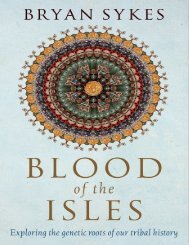Create successful ePaper yourself
Turn your PDF publications into a flip-book with our unique Google optimized e-Paper software.
my father’s consignment contained, in addition to Farmer Giles of Ham, Mr Bliss, and The<br />
Lost Road, two elements referred to as Long Poem and The Gnomes Material, titles which<br />
carry a suggestion of despair. Obviously the unwelcome manuscripts landed on the desk at<br />
Allen and Unwin without adequate explanation. I have told in detail the strange story of this<br />
consignment in an appendix to The Lays of Beleriand (1985), but to be brief, it is painfully<br />
clear that the Quenta Silmarillion (included in ‘the Gnomes Material’, together with<br />
whatever other texts may have been given this name) never reached the publishers’ reader—<br />
save for a few pages that had been attached, independently (and in the circumstances very<br />
misleadingly) to The Lay of Leithian. He was utterly perplexed, and proposed a solution to<br />
the relationship between the Long Poem and this fragment (much approved) of the prose<br />
work (i.e. the Quenta Silmarillion) that was (very understandably) radically incorrect. He<br />
wrote a puzzled report conveying his opinion, across which a member of the staff wrote,<br />
also understandably, ‘What are we to do?’<br />
The outcome of a tissue of subsequent misunderstandings was that my father, wholly<br />
unaware that the Quenta Silmarillion had not in fact been read by anybody, told Stanley<br />
Unwin that he rejoiced that at least it had not been rejected ‘with scorn’, and that he now<br />
certainly hoped ‘to be able, or to be able to afford, to publish the Silmarillion!’<br />
While QS II was gone he continued the narrative in a further manuscript, which told of the<br />
death of Beren in The Wolf-hunt of Carcharoth, intending to copy the new writing into QS II<br />
when the texts were returned; but when they were, on 16 December 1937, he put The<br />
Silmarillion aside. He still asked, in a letter to Stanley Unwin of that date, ‘And what more<br />
can hobbits do? They can be comic, but their comedy is suburban unless it is set against<br />
things more elemental.’ But three days later, on 19 December 1937, he announced to Allen<br />
and Unwin: ‘I have written the first chapter of a new story about Hobbits—“A long expected<br />
party”.’<br />
It was at this point, as I wrote in the Appendix to The Children of Húrin, that the<br />
continuous and evolving tradition of The Silmarillion in the summarising, Quenta mode<br />
came to an end, brought down in full flight, at Túrin’s departure from Doriath, becoming an<br />
outlaw. The further history from that point remained during the years that followed in the<br />
compressed and undeveloped form of the Quenta of 1930, frozen, as it were, while the great<br />
structures of the Second and Third Ages arose with the writing of The Lord of the Rings. But<br />
that further history was of cardinal importance in the ancient legends, for the concluding<br />
stories (deriving from the original Book of Lost Tales) told of the disastrous history of<br />
Húrin, father of Túrin, after Morgoth released him, and of the ruin of the Elvish kingdoms of<br />
Nargothrond, Doriath, and Gondolin of which Gimli chanted in the mines of Moria many<br />
thousands of years afterwards.<br />
The world was fair, the mountains tall,<br />
in Elder Days before the fall<br />
of mighty kings in Nargothrond<br />
And Gondolin, who now beyond<br />
the Western Seas have passed away . . .<br />
And this was to be the crown and completion of the whole: the doom of the Noldorin Elves<br />
in their long struggle against the power of Morgoth, and the parts that Húrin and Túrin played
















